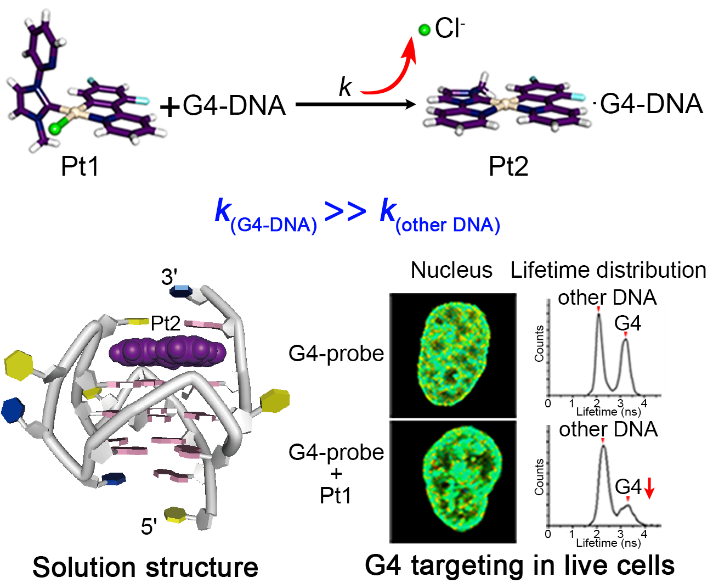The new progress of Professor Mao Zongwan’s team in the complex binding G-quadruplex: a selective targeting spatiotemporal controlled strategy
Source: School of Chemistry
Edited by: Tan Rongyu, Wang Dongmei
Guanine-rich nucleic acid sequence can form an atypical secondary structure, G-quadruplex (G4), which is commonly found in regions with important biological functions such as human telomeres and gene promoters. In recent years, G4 has become a potential target for the development of anti-cancer drugs. Small molecule compounds that can recognize and selectively bind to G4s exhibit anti-tumor activity by regulating the expression of their corresponding genes. However, the design of selective G4-binders still faces great challenges. Common strategies for designing G4-interactive small molecules are mainly focused on compounds containing extended planar aromatic moieties with positive charges. To explore the binding process and structure determination are very crucial for the understanding of ligand/G4 interaction mechanisms, which is important for investigating the selective binding of G4 and provides structural information and theoretical basis for the rational design of small molecule drugs.
Recently, Professor Mao Zongwan’s team of Sun Yat-sen University reported a platinum complex
Pt1 that can selectively bind to G4 DNA through spatiotemporal controlled selective targeting (Figure 1). NMR structure information showed that Cl- hydrolysis under the action of G4s DNA, and the N-heterocyclic carbene ligand rotates adaptively, transforming
Pt1 into a planar structure. At the same time, the residues binding sites of G4 DNA display self-adaptive rearrangement. These processes activate the mutual matching and binding between
Pt1 and G4 DNA. Kinetic studies have shown that the Cl- dissociation rate of
Pt1 is the rate determining step of DNA binding. The Cl- dissociation rate of Pt1 bound to G4 DNA is 2-3 orders of magnitude higher than that of bound double-stranded DNA and its self-hydrolysis. Thus, the selectivity of
Pt1 to G4 was achieved in the kinetic rate. In addition, team members demonstrated that
Pt1 can target G4 DNA in the nucleus of living cells and effectively inhibit the expression of VEGF mRNA and protein by using competitive experiments with G4 fluorescent lifetime probes. At the same time, the experiments in vivo further showed that
Pt1 significantly inhibited the growth of zebrafish blood vessels and achieved effective anti-tumor effects.

Figure 1:
Pt1 kinetic controlled selectively binds to G-quadruplex DNA
Professor Mao Zongwan’s team proposed a new spatiotemporal controlled strategy for selective targeting of G4 for the first time, which is, the self-adaptive structure transformation activates the interaction between small molecules and G4 DNA, and the selectivity of small molecules to G4 is controlled by kinetics. Different from the traditional thermodynamic control mode, this new targeting mode is controlled by kinetics. The inert coordination bond of the complex modulates the selective binding. It provides new ideas for the development and design of small molecules targeting G4 or other biomolecules.
Recently, the work was published in the top chemistry journal
Angewandte Chemie International Edition as a communication, with the title “Selectivity and Targeting of G-Quadruplex Binders Activated by Adaptive Binding and Controlled by Chemical Kinetics”.
Zhu Bochen, a doctoral student in the School of Chemistry, Sun Yat-sen University, is the first author of the paper. Associate researcher Liu Wenting and Professor Mao Zongwan are the corresponding authors of the paper. This research work was funded by the National Natural Science Foundation of China, the Innovation Team of the Ministry of Education, the Natural Science Foundation of Guangdong Province, and the Fundamental Research Funds for the Central Universities.
Link to the paper:
https://doi.org/10.1002/ange.202104624
